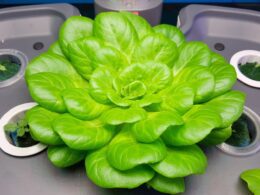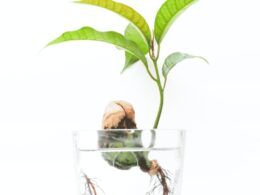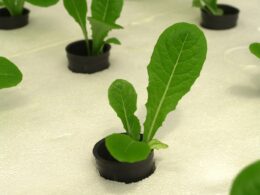Are you interested in starting a hydroponic garden? One of the most important aspects of successful hydroponics is ensuring that your water is pure and free of contaminants. Tap water may contain minerals, chlorine, and other impurities that can harm your plants or reduce their growth potential. Fortunately, there are many options for purifying your tap water before using it in your hydroponic system.
In this article, we’ll explore the different types of water purification methods available for hydroponics, how to choose the right system for your setup, and how to maintain and monitor your purified water. By following these steps, you’ll be able to provide your plants with the clean, nutrient-rich water they need to thrive.
Let’s dive in and learn how to purify tap water for hydroponics.
Understanding the Importance of Water Purification for Hydroponics
It’s crucial to ensure your plants are receiving the highest quality H2O possible in order to maximize their growth potential and overall health. Using tap water for hydroponics may seem like an easy and cost-effective solution, but it’s important to understand the benefits of purified water.
Purified water is free from harmful contaminants and chemicals that can negatively impact your plants’ growth. It’s also pH-balanced, which is essential for hydroponic systems.
On the other hand, using unfiltered water for hydroponics can lead to potential risks. Tap water often contains chlorine, chloramine, and other chemicals that can harm your plants. These chemicals can affect the pH balance of your system, leading to stunted growth or even death of your plants. In addition, tap water can carry harmful bacteria and pathogens that can spread throughout your system, causing disease and other issues.
To ensure your plants receive the best possible water, it’s important to purify your tap water before using it in your hydroponic system. This can be done through various methods, such as using a reverse osmosis filter, a carbon filter, or a combination of both.
By purifying your tap water, you can rest assured that your plants are getting the cleanest and healthiest water possible, leading to optimal growth and a bountiful harvest.
Types of Water Purification Methods
When it comes to purifying water for hydroponics, there are a few methods you can use. The first method is reverse osmosis, which uses a semi-permeable membrane to filter out impurities from the water.
Another method is carbon filters, which absorb contaminants and improve the taste and odor of the water.
Lastly, UV sterilization uses ultraviolet light to kill bacteria and viruses in the water.
Reverse Osmosis
Using reverse osmosis, you can remove impurities and create pure H2O for your hydroponic system. Reverse osmosis is a water purification process that filters out contaminants such as minerals, chemicals, and bacteria. Here are a few benefits of using reverse osmosis for your hydroponic system:
- Removes up to 99% of impurities: Reverse osmosis can effectively remove impurities such as heavy metals, chlorine, and pesticides from tap water.
- Improves plant growth: By providing pure water, your plants can absorb nutrients more efficiently, leading to healthier growth and higher yields.
- Reduces the risk of disease: Using reverse osmosis water reduces the risk of diseases caused by bacteria, fungi, and viruses in your hydroponic system.
- Saves money in the long run: By using reverse osmosis, you’ll reduce the need for expensive water additives and improve the lifespan of your hydroponic equipment.
- Easy to maintain: Reverse osmosis systems are easy to maintain and operate, making it a convenient option for hydroponic growers.
Investing in a reverse osmosis system can provide you with clean and pure water for your hydroponic system. By removing impurities and improving water quality, you can ensure healthy plant growth and reduce the risk of disease.
Make sure to test your water quality before and after using reverse osmosis to ensure optimal results.
Carbon Filters
If you want to ensure that your plants stay healthy and disease-free, investing in a carbon filter is a must for your hydroponic system. Carbon filters are the most effective way to remove impurities from tap water, especially those that can be harmful to plants.
Activated charcoal, the key ingredient in carbon filters, is highly absorbent and can trap and remove chlorine, pesticides, herbicides, and other contaminants from your water. Before water passes through the activated charcoal, it must first go through sediment filtration to remove any larger particles that could clog the carbon filter.
Sediment filtration uses a physical barrier, like a mesh screen, to trap and remove larger particles like sand, dirt, and rust. Once the water has been properly filtered, it will be free of impurities and safe for your plants to use.
In addition to improving the health of your plants, using a carbon filter can also improve the taste and odor of your water, making it more enjoyable to drink as well.
UV Sterilization
The next step in keeping your plants healthy is with a UV sterilization system. This system uses ultraviolet light to kill any remaining bacteria or viruses in your water, making it safe for your hydroponic plants.
Here are some benefits of using a UV sterilization system and how it compares to other water purification methods:
-
Effectiveness: UV sterilization is highly effective in killing bacteria and viruses, making it one of the best water purification methods available.
-
Chemical-free: Unlike other water purification methods, UV sterilization doesn’t use chemicals such as chlorine, which can harm your plants.
-
Low maintenance: UV sterilization systems require little maintenance and only need to be replaced once a year, making it a cost-effective solution for long-term use.
Overall, using a UV sterilization system is a great way to ensure that your hydroponic plants are getting the cleanest and safest water possible. Compared to other water purification methods, UV sterilization is highly effective, chemical-free, and low maintenance, making it a top choice for hydroponic growers.
What Methods Can I Use to Treat Tap Water for Hydroponics?
There are several effective methods for treating tap water for hydroponics. One option is using a reverse osmosis system to remove impurities. Another method is using carbon filters to eliminate chlorine and other contaminants. Additionally, UV sterilization can help kill bacteria and pathogens. Overall, these methods ensure clean and suitable water for hydroponic systems.
Choosing the Right Water Purification System for Your Hydroponic Setup
Picking the proper water purification system is essential for achieving a successful hydroponic setup. With the multitude of options available, it can be overwhelming to choose the right one. To help you decide, here is a table comparing three common water purification systems: reverse osmosis, activated carbon filtration, and distillation.
| System | Pros | Cons |
|---|---|---|
| Reverse Osmosis | Removes up to 99% of impurities | Cost effective options may not be as effective |
| Activated Carbon Filtration | Removes chlorine and organic compounds | May not remove all impurities |
| Distillation | Removes all impurities | Expensive and time-consuming |
When selecting a water purification system, it’s important to consider your budget and the quality of your tap water. If your tap water is already relatively pure, activated carbon filtration may be sufficient. However, if your tap water is heavily contaminated, reverse osmosis or distillation may be necessary. Keep in mind that while a more expensive system may provide better results, it may not necessarily be the most cost-effective option in the long run.
In order to ensure the success of your hydroponic setup, it’s crucial to invest in a water purification system that meets your specific needs. By carefully considering the pros and cons of each option, you can make an informed decision and create a safe and healthy environment for your plants to thrive.
Installing and Maintaining Your Water Purification System
To ensure your water is always pure and your plants are healthy, it’s important to know how to install and maintain your chosen water purification system.
When installing your system, make sure to follow the manufacturer’s instructions carefully. Make sure to install all the necessary filters and cartridges to ensure your tap water is purified properly. Additionally, it’s important to regularly check and replace these filters to maintain the effectiveness of the system.
Maintaining your water purification system is crucial for the longevity of the system and the health of your plants. One cost-effective option is to use a TDS meter, which measures the total dissolved solids in your water. If the TDS level is higher than recommended, it’s time to replace the filters.
Another common issue is bacteria growth within the system. To prevent this, regularly sanitize the system and replace the filter cartridges as recommended by the manufacturer.
By following these tips, you can ensure your water purification system is properly installed and maintained, resulting in healthy plants and a thriving hydroponic setup.
If you encounter any issues, be sure to troubleshoot the problem by referring to the manufacturer’s instructions or seeking advice from a hydroponic expert. Remember, a well-maintained water purification system is essential for the success of your hydroponic garden.
Monitoring Water Quality and Adjusting Nutrient Levels
Now that you’ve set up your water purification system, it’s important to monitor the quality of your tap water. One way to do this is by regularly testing nutrient levels and pH balance.
Nutrient testing involves measuring the levels of nitrogen, phosphorus, and potassium in your water. These nutrients are essential for plant growth and development. You can purchase nutrient testing kits at your local gardening store or online. Regular testing will help you determine when to add more nutrients to your water to ensure that your plants are receiving the optimal levels.
pH balancing is another important factor to consider. The pH level of your hydroponic system should be between 5.5 and 6.5 for optimal plant growth. You can use pH testing kits to measure the acidity levels in your water. If your pH levels are too high or too low, you can adjust them by adding pH balancing solutions.
By monitoring the quality of your tap water and adjusting nutrient levels and pH balance as needed, you’ll be able to maintain a healthy hydroponic system and achieve successful plant growth. Remember to continue testing and adjusting regularly to ensure the best results for your plants.
Frequently Asked Questions
Can I use tap water without purifying it for hydroponics?
Using tap water for hydroponics without purifying it can be risky. Tap water contaminants can harm your plants and even pose a health risk to you. Tap water safety is a concern as it may contain chemicals like chlorine, fluoride, and heavy metals like lead, arsenic, and mercury. These contaminants can affect the pH, nutrient levels, and growth of your plants.
Therefore, it’s essential to purify your tap water to remove these harmful elements before using it for hydroponics. To ensure tap water safety, you can use a water filtration system or add a water conditioner to neutralize the chemicals and make it suitable for hydroponics. It’s always better to be safe than sorry when it comes to your health and the health of your plants.
How often should I change the water in my hydroponic system?
Keeping your hydroponic system’s water fresh is crucial for healthy plant growth. The benefits of recycling hydroponic water are numerous, including saving money on water bills and reducing environmental impact. However, it’s important to monitor the water temperature in your hydroponic system regularly, as temperature changes can affect your plants’ growth and the growth of harmful bacteria.
As a general rule, it’s recommended to change the water in your hydroponic system every two to three weeks. However, this can vary depending on the type of plants you’re growing, the size of your system, and the water quality. By regularly monitoring your water temperature and changing the water when necessary, you can ensure your hydroponic system stays healthy and your plants thrive.
What is the ideal pH level for hydroponic water?
Maintaining proper pH levels in hydroponic systems is crucial for the health and growth of your plants. The ideal pH level for hydroponic water is between 5.5 and 6.5.
When pH levels are too high or too low, it can lead to nutrient deficiencies, stunted growth, and even death of your plants. Fortunately, there are common pH adjustment solutions for hydroponic water, such as pH up or pH down solutions.
Regularly monitoring and adjusting your pH levels will provide numerous benefits, including improved nutrient uptake, increased plant growth, and a higher yield. Don’t neglect the importance of pH in your hydroponic system, ensure your plants receive the right balance of nutrients with proper pH management.
Can I use rainwater for hydroponics?
Using rainwater for hydroponics can have its pros and cons. On one hand, rainwater is free and contains natural nutrients that can be beneficial for plant growth. It also has a lower pH level, which can be advantageous for certain plant species.
On the other hand, rainwater can be contaminated with pollutants and bacteria, especially if collected from roofs or other surfaces. Tap water, on the other hand, is treated and purified to remove harmful chemicals and microorganisms, making it a safer and more reliable option.
Ultimately, the decision between rainwater vs tap water for hydroponics depends on the quality of the available water sources and the specific needs of your plants.
How do I know if my water purification system is working properly?
To ensure the safety of your water supply, it’s essential to know if your water purification system is working correctly. Common contaminants that may be present in the water include bacteria, viruses, and chemical pollutants.
Testing methods can vary, but the most reliable way to test your water is through a certified laboratory. You can also perform simple tests at home using water test kits. These tests can detect the presence of harmful bacteria, nitrates, and other contaminants.
Regularly testing your water can help you identify any issues and ensure that your water purification system is working effectively.
Conclusion
Congratulations on taking the first step towards ensuring your hydroponic plants have the highest quality water possible! By understanding the importance of water purification and choosing the right system for your setup, you can provide your plants with the cleanest and healthiest environment to thrive in.
Remember to regularly monitor your water quality and adjust nutrient levels accordingly to keep your plants happy and healthy. With a little effort in installing and maintaining your water purification system, you can enjoy the benefits of a thriving hydroponic garden.
So, get started today and watch your plants flourish!









